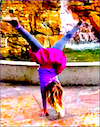
Now and then in upcoming months, you’ll see pieces I write tagged with the word “cartwheeling.” The series responds to a cluster of questions I’ve struggled with since the 2016 election. As I’ve puzzled over how I can best contribute in a changed and changing world, I’ve written essays with questions as titles: “What should a concerned citizen do?” “So many ideas, so much to do – what’s next?” and, “What’s my piece of the puzzle? Is resistance enough?” I’ve thought of these as my “puzzle pieces.” The Cartwheeling series is one way I’m answering these questions.
So why cartwheels?
As I’ve tried to figure out my role, I’ve had to accept as given my stubbornly positive disposition. This has been its own kind of stumbling block, which I explore in “Pollyanna?” As I wrote that piece, I realized that the sense of possibility I get from leaping into things feels akin to my 8-year-old granddaughter Livia’s cartwheeling spirit. I can learn from her. Livia can and does cartwheel anywhere, even on the way home from school in the winter while wearing her huge, flowered backpack.
“Cartwheeling” as a rubric works for me. I loved the feeling of doing cartwheels as a kid, though the idea of this 73-year-old trying it now is daunting, if not a little scary. Mentally though, I like the idea of cartwheeling as another way to carry on. After all, you have to turn upside down to do a cartwheel. And to find our way to a better future we need to turn many of our ideas and assumptions upside down, then right side up, and upside down again.
Cartwheeling isn’t just a solo act. It can be an exchange, a conversation. I ran across a news story from Washington DC about a “conversation” between a kid and a cop by cartwheel and backflip. The kid’s challenge came first. The cop followed in kind.
Cartwheeling can be done anywhere, in Westminster Abbey by a joyful clergyman after the wedding of Prince William and Catherine Middleton and in Antarctica by a team of graduate students taking a break from McMurdo Station.
It can also be teamwork. We can learn to double cartwheel and everybody-all-at-once cartwheel.
Cartwheeling is moving by revolving. How many revolutions, or kinds of revolutions, will it take to get there, to get where we want to go? It’s not the fastest or the easiest way, but working together a Canadian team of ten doing cartwheels travelled 31 miles in a single 24-hour period to set a record.
The road can’t just be about efficiency and how fast we’re going. It also has to be about where we’re going and how we get there. The phrase “doing cartwheels,” after all, means to feel good about something. We might even get farther and accomplish more if we know where we’re heading and if we move with spirit and joy in the possibility of finding ways to get out of this mess.
![]()
I’ll use the Cartwheeling series to share stories about work done and action taken by friends and others who inspire me and give me hope. I have many examples already; more will come. Two follow here. “Honestly, you have been very patient with me” was originally posted as a comment on my “Pollyanna?” piece. Then, Boting Zhang writes, in “Beneath Partisan Politics,” of her shocked response to the 2016 election. Bo didn’t wait to take action. Born in China and raised with images of America as “Meiguo– the Beautiful Country,” she writes, “the America of my young imagination compelled me to facilitate a year-long conversation across the red-blue divide.” With Between Americans, a conversation that involved 12 people who voted for Clinton and 12 who voted for Trump, she wanted to understand and perhaps help bridge the polarization in this country. What she learned is not what she expected.
In Cartwheeling I’ll look for connecting threads, broad ideas or theories that tie the various stories together and add to their power. I’m finding books and other materials that may help. At the end of 2016, in “A bigger choir – a countervailing force,” I expressed my frustration with the, usually disapproving, expression, “You’re just speaking to the choir.” It’s one of the assumptions we need to turn upside down, a small one perhaps, but for me a beginning. At the time I suggested that instead of being critical of speaking to the choir, “We should work to expand the choir, build connections with other choirs, welcome different voices in our own, and allow for differences since dissonance is a powerful part of music.” I wondered whether we can create a force that incorporates the strengths of both our differences and what we share.
As we start to understand these connections and their potential power, we have to figure out how to move together with them. Cartwheels are all about movement, but backwards cartwheeling is nearly impossible. We can’t go back. We need new ways to understand where we are and, as importantly, we need to imagine how we want to move and where we want to go.
![]()
References
(a few links are videos, most are not)
“Pollyanna?”
“What should a concerned citizen do? November 15, 2016”
“So many ideas, so much to do – what’s next?”
“What’s my piece of the puzzle? Is resistance enough?”
“A cop shows off to a group of kids with an epic cartwheel and backflip,” ABC News, 7/1/18 (video)
“Cartwheeling ‘clergyman’ can’t contain wedding joy,” Channel 4 News (UK), 4/29/11 (video)
Greg’s Antarctica adventures, “Leading trips to Room with a View,” by Greg Zerban, February 19, 2014
“How to do a double cartwheel” by the Cheernastics2” (video)
“Olympian Gabby Douglas attempts cartwheel record,” in St. Paul, MN ABC News, 6/4/14
“A bigger wave – a countervailing force,” Anne Focke, December 31, 2016
![]()


